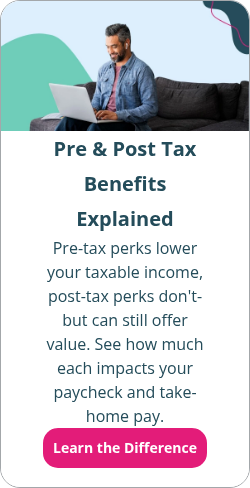Exempt vs. non-exempt employees
By Elizabeth Walker on August 19, 2024 at 10:35 AM
As a small business owner, you can probably define terms like minimum wage, overtime hours, and job duties. But you may not know what exempt or non-exempt means or how to categorize your employees as one or the other.
Understanding these terms is vital for complying with the Fair Labor Standards Act (FLSA), which establishes labor law regulations for employers1. While regulations can vary by state, all employers must follow some of the same basic rules. For instance, all employers need to ensure they are classifying their employees correctly. Any misclassification that leads to unpaid overtime wages can have serious financial consequences for your business.
To help you avoid these missteps, we'll review what exempt and non-exempt employees are and how you must treat each type of employee. We’ll also cover how you can offer comprehensive health benefits to both groups.
In this blog post, you’ll learn:
- The difference between exempt and non-exempt employees.
- How exemption status affects job duties and salary requirements, including wages and overtime pay.
- The risks of misclassifying employees, including potential legal and financial penalties.
What are exempt employees?
Exempt employees are individuals who are exempt from a minimum hourly wage, overtime rules, and other FLSA requirements. Instead, these types of workers typically receive an annual salary.
As of July 1, 2024, exempt workers must earn at least $844 weekly to comply with federal law. The threshold will rise to $1,128 weekly on January 1, 20252. If you have employees in a state that sets its own minimum wage requirements, check out the state’s wage laws to determine the minimum salary for exempt employees. Your employee's job role and professional duties must also meet specific DOL exemption requirements.
Employees with exempt status tend to have “executive” or “professional” jobs. They can receive year-end bonuses or special perks and benefits to compensate for the difficulty of their work.
Additional requirements for exemption vary by state. But the FLSA outlines them as:
- Executive employees. According to the U.S. Department of Labor (DOL) Wage and Hour Division, an individual must meet the following requirements to qualify for this exemption:
- They must receive a weekly salary of at least $844 in 2024 and $1,128 in 2025.
- Their primary duty must be managing some or all of the organization.
- They must oversee the work of at least two or more other full-time employees.
- They must be able to hire or fire other employees or have a say in the decision.
- Administrative employees. To qualify for this exemption, the worker must:
- Receive a salary of at least $844 per week in 2024 and $1,128 in 2025.
- Primarily handle office work related to managing business operations.
- Use their best judgment when working on significant business matters.
- Professional workers. To qualify, employees must:
- Have a weekly salary of at least $844 in 2024 and $1,128 in 2025.
- Work a job that requires advanced knowledge that is predominantly intellectual, such as the education or science field.
- They must also acquire the necessary knowledge through higher learning classes or an advanced degree.
- Outside sales employees. An individual must meet the following requirements to be eligible for this exemption.
- Their primary duty must be in a sales role or collecting service orders or contracts.
- They generally must work outside the employer’s place of business.
- Computer-related occupations. To qualify for this exemption, employees must:
- Have a weekly salary of at least $844 in 2024 and $1,128 in 2025.
- Be a computer programmer, computer systems analyst, software engineer, or other similar computer science skilled worker.
A salaried worker isn’t necessarily exempt, as non-exempt workers can also receive an annual salary. Similarly, some exempt computer professionals, teachers, lawyers, and doctors receive an hourly rate instead of a salary.
What are non-exempt employees?
Non-exempt employees are workers who earn at least the federal hourly minimum wage and qualify for overtime provisions. As the name suggests, these workers aren't exempt from FLSA regulations.
Non-exempt employees tend to have higher-level supervisors and managers. Their primary duty is to carry out tasks without making management decisions.
A few examples of non-exempt employees are:
- Construction and maintenance workers
- Assembly line workers
- Freelancers and independent contractors
- Retail associates
- Hospitality and food workers
- Railroad workers
Even if non-exempt workers earn more than minimum wage, they may have a supervisor. They also may not hold an executive position.
Hourly employees aren’t necessarily the same as non-exempt workers. While non-exempt employees typically receive an hourly wage, it's not a requirement for an employee to be non-exempt. You can pay non-exempt employees a commission or salary if the compensation meets minimum wage requirements.
How does exemption status affect wages?
To be exempt, an employee must meet a salary threshold of at least $844 per week—or $43,888 per year in 2024. As stated above, these employees are exempt from overtime provisions. However, you can offer them additional compensation via their benefits package.
Non-exempt workers must receive at least the federal minimum wage of $7.25 per hour. But, some states with a higher cost of living have minimum wages above the federal base. Currently, 34 U.S. states have a higher minimum salary threshold than the federal amount3.
You must follow the federal overtime pay requirement for these employees, which is 1.5 times their regular pay rate for every hour they work over a 40-hour workweek. However, you aren’t federally required to pay highly compensated non-exempt employees who make $132,964 or more annually (rising to $151.164 annually in 2025) overtime.
It’s possible to have a non-exempt salaried employee. This happens if you have employees who don't meet the job duty requirements, earn less than $844 per week or $43,888 per year, or have pay deductions that bring them under the salary thresholds. In these cases, they may be eligible for the overtime rate.
What are the penalties for misclassifying an employee?
If you misclassify an employee as exempt when they're non-exempt, you may have to pay unpaid overtime wages to the employee going back three years. The court may also require you to pay the employee damages equal to the total amount of their unpaid wages. This can double the amount of money the employee may receive.
You could also face costly compliance violations. If you intentionally or repeatedly misclassify employees as exempt, you may have to pay up to $1,000 in civil penalties for each offense. Criminal prosecution is also a possible disciplinary action, resulting in a fine of up to $10,000 and/or jail time.
How you can offer health benefits to exempt and non-exempt employees
No federal law requires you to provide the same benefits to all your employees. But, if you're considering offering different health benefits to different employees based on exemption status, you must do it legally.
Business owners wanting to offer specific employee benefits or different perks to various workers must use “bona fide employment-based classifications.”
For instance, you could offer different levels of benefits based on employee classes like:
- Full-time or part-time job status
- Salaried workers or hourly basis workers
- Whether an employee works in or out of state
- An employee's job title
- An employee's seniority
These classifications of employees are legal because they're anti-discriminatory and not based on characteristics like race, sex, disability, or religion. You must treat employees in the same class equally, meaning they must receive the same level of benefits.
These rules apply to all health benefits options, including non-traditional benefits like health reimbursement arrangements (HRAs) and taxable employee stipends.
|
HRAs |
Employee stipends |
|
An HRA is an employer-funded health benefit employers can use to reimburse employees, tax-free, for their health insurance premiums and more than 200 types of out-of-pocket medical expenses. |
Employee stipends are taxable, fixed amounts of money employers offer to each employee to help them pay for health, wellness, and other various expenses. |
Setting employee classes with these benefits can help employers offer different allowance amounts to different types of employees to better attract and recruit workers at your organization. However, not all HRAs support all employee classes.
Below are how different types of HRAs work with exempt and non-exempt employees:
- Suppose you have an individual coverage HRA (ICHRA) or a group coverage HRA (GCHRA). In that case, you can offer your salaried employees more money per month to spend on healthcare items than your non-salaried workers. The ICHRA allows customization for 11 employee classes, while the GCHRA allows for seven.
- You can’t differ allowances by exempt or non-exempt status with a qualified small employer HRA (QSEHRA). But you can vary allowance amounts by age and family size.
If you're offering a stipend, the rules around employee classes are more flexible because stipends aren't as formal as HRAs. With a stipend, you can create any employee classes you want, as long as they aren’t discriminatory. You aren’t allowed to design a class that specifically excludes an employee from receiving the benefit.
Conclusion
The FLSA determines whether or not an employee is exempt or non-exempt. But, you must follow the proper classification requirements to avoid penalties. To determine if your workers are exempt or non-exempt employees, double-check how much money they earn, their work type, and their specific professional duties.
Regardless of the type of employee, you should offer an enticing benefits package to recruit and retain talented workers. Luckily, with an HRA through PeopleKeep, you can provide your entire workforce with personalized and flexible health benefits. Schedule a call with an HRA advisor to learn more.
This article was originally published on July 27, 2022. It was last updated on August 19, 2024.
1. https://www.dol.gov/agencies/whd/flsa
2. https://www.dol.gov/agencies/whd/overtime/salary-levels
Check out more resources
See these related articles

Health reimbursement arrangement (HRA) eligibility FAQs
Get answers to common questions about HRA eligibility. Learn who qualifies and how health reimbursement arrangements work for employers and employees.

What is an HRA?
Learn what a Health Reimbursement Arrangement (HRA) is, how it works, and how it benefits both employers and employees in managing healthcare costs.

What is healthcare reimbursement?
Looking to reimburse your employees for their healthcare expenses? Learn everything you need to know about healthcare reimbursement.



